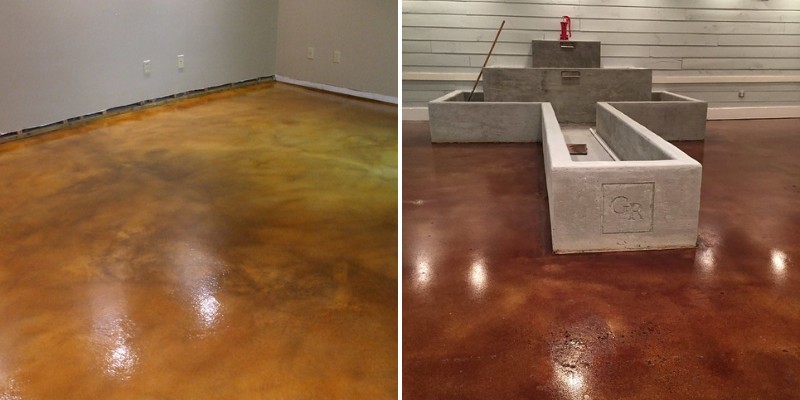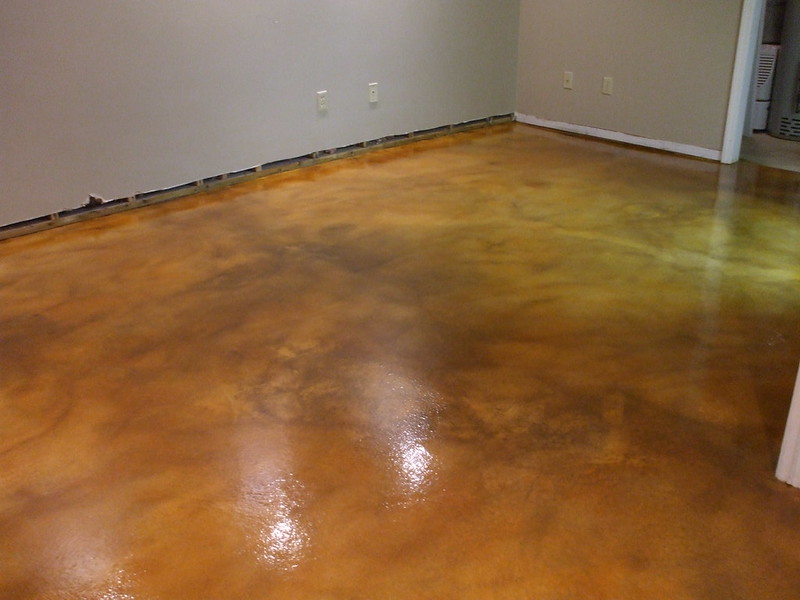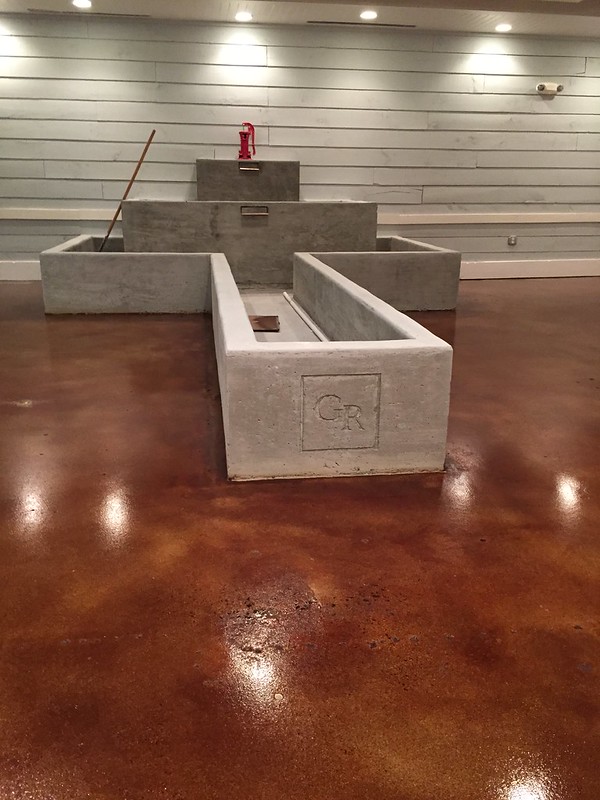According to the Concrete Networking website, staining concrete floors has become so popular, it is fast becoming the most attention-getting way to achieve a fashionable, durable floor finish that is also traffic-stopping.

Concrete stain products are versatile. They penetrate concrete deeply so building owners enjoy fade-resistant, permanent color finishes that will neither peel nor flake off once stains are applied.
Whether you are looking at concrete staining as a solution for your interior space or your intention is staining the concrete flooring at a commercial establishment requiring a finish that is ready to stand up to heavy traffic patterns, stained concrete floors makes great options.
Sound like a method of refinishing concrete flooring that you would like to try for yourself? Whether you’re tackling the floor of a business establishment or refinishing a concrete patio, consider these pros and cons before you head to the hardware store to select a concrete floor stain product.
Pros of Stained Concrete Flooring
- Stained cement is environmentally friendly. Stain your concrete floors for a permanent solution that can last for a century. You won’t have to replace wood, faux wood, carpet or tile, all of which are likely to wind up in landfills once they no longer serve their purposes. By taking a pass on wood flooring you contribute to efforts aimed at ending logging. This practice clears forests of trees that produce oxygen, serve as homes for birds and wildlife. Left standing, trees help cut back on toxic emissions spewing into the atmosphere from factories and fuels, too.
- Enjoy limitless design flexibility and versatility. Your color and pattern options are limitless, so whether your interior happens to be industrial, modern, traditional or earthy, you can easily find products that will deliver the look you seek. It’s easy to be creative. Use just one stain color, mix up a few hues or create a more fanciful floor by using custom graphics favored by businesses eager to imprint logos, images, zone lines and artistic touches over their floor expanses.
- Concrete floors have character, say contractors at Vanguard Concrete Coating, a company that specializes in these jobs. “Concrete stain does more than simply add color. Rather than produce a solid, opaque effect like paint or colored coatings, stains permeate the concrete to infuse it with rich, deep, translucent tones.” There is literally no other way to get this type of decorative floor finish and since no two floors will look alike, concrete lends its own personality to the colors and patterns you choose.
- Pick the stain product that suits your needs. Acid-based stains react chemically with the concrete, penetrating and delivering unique mottling effects that can be mistaken for granite or marble surfaces. Acid-based products are ideal for any floor that calls for a “wood” look and since color palettes associated with these products are usually limited to earth tones, mellow, natural-looking colors result. Choose a water-based stain and your results can be much more dramatic due to the chemical composition of these types of products, so if you’re going for “unique,” water-based products are a perfect choice.
- Gain endless advantages, say editors at Australia’s version of “Home and Gardens” magazine. No matter how much abuse your concrete floor is subjected to, it will remain gorgeous. Call in the kids and dogs and invite them to drag their toys across the floor. Further if residents in your home suffer sensitivities and allergies, you avoid triggers that carpeting attracts, including dust mites and moisture. Even chemical spills stand up to concrete floor stain products. Further, some stain applications may produce energy efficiencies since concrete absorbs sunlight that is released into rooms once the sun sets.

Cons of Stained Concrete Flooring
- This floor isn’t for bare footers. Stained concrete floors while beautiful are not conducive to comfort if you roam around in bare feet because not only is concrete cold but it can be hard to stand on it for long periods of time – which means that household tasks like washing dishes and other jobs can be uncomfortable. This is especially true for people with arthritis, bone and joint issues.
- If you drop things, they’re toast. Cushioned flooring options – tile, carpet and some woods – tend to have some “give” that makes standing on them for longer periods of time easier and with these flooring options, you stand a better chance of keeping your possessions in one piece. Drop even non-fragile items on stained concrete floors and you could find yourself in the business of replacing household and family treasures like crystal, china and any items that are the least bit fragile. Consider investing in thick mats once your cement floor is stained.
- Staining a concrete floor takes time. Depending upon the staining product you choose, you could spend from two to five days applying this finish. The more complicated the number of design features and colors, the longer the process. This applies only to concrete that is already in good shape. “Concrete slabs in new homes will need to cure before stains can be applied. Newly poured and custom-detailed concrete floors can take weeks to install and finish,” say experts writing for “Home and Gardens” magazine.
- You may not want to do the job yourself. Though the process of concrete floor staining is relatively straightforward – clean the cement, apply the stain, clean and neutralize the stain and seal the surface – this is a job best left to experts for myriad reasons. Surface prep must be impeccable or you’ll wind up with uneven coloration across the floor surface and that’s the least of it. Finding a contractor skilled in the art of cement floor staining will cost you extra money but keep this in mind: Stain is permanent. If you make mistakes, there’s no going back.
- Staining concrete won’t hide floor flaws. While a careful staining job will improve the look of a concrete floor, stains – especially if you opt for an acid-based product – won’t hide imperfections and in fact, the stain could make them look worse. Even small issues like cracking or discolorations on surfaces can be intensified once a stain is applied and the floor finishes drying. You can avoid some of this if you take Herculean methods to prepare the floor before you stain, but if you find that you can’t rectify things, you may not want to proceed.

How much does concrete flooring cost to stain?
According to Home Advisor’s 2020 survey on stained concrete flooring costs, you can expect to spend around $1,000 to have 1,000-square-feet of area done, but that’s not the end of the story.
In some cases, a simple stain job could run you only $3,000 if you use a contractor who doesn’t specialize in this service, but if you are going for a look that is magazine worthy, you could easily spend $18,000 or more, say Home Advisor analysts.
Taken down the smallest denominator, you would be wise to budget between $7 and $15 per square foot just for supplies.
Add between $2 and $4 per square foot if you’re using a contractor. The room you choose may add or subtract from your overall expenditures.
If your intent is to stain a patio rather than an interior room, add film-forming sealers (up to 50-cents per square foot) and penetrating sealers (up to 75-cents per square foot), so the sun’s UV rays don’t go to work on your beautifully stained exterior floor finish. You will also spend more if you opt for an acid-based stain.
Polished vs Stained Concrete; which is right for you?
Around 25 years ago, homeowners began to follow the trend of using natural cement as a flooring option and with that new option, confusion arose between the arts of polished versus stained concrete.
The confusion persists to this day and contractors often ask clients to spell out their objectives so they don’t deliver the wrong finish. This tutorial will help you differentiate between the two so you don’t make that mistake.
Polished concrete is a durable, water-resistant floor treatment that requires preparing cement surfaces with a planetary grinder that opens up concrete pores.
Once done, a contractor makes multiple passes over the entire surface using “successively finer-grit diamond products, along with chemical hardeners” according to experts at Sherwin-Williams. The last step is the application of an acetone dye that is followed by a protective finish/sealer.
Polished concrete is not recommended for outdoor surfaces and it is a much more expensive process than staining concrete, though it’s ideal for high-traffic floors prone to high traffic.
Stained concrete is much less expensive, whether you choose acid-or water-based products because the process of preparing the surface is much less labor intensive.
While “pores” are opened on surfaces being groomed for a polished concrete result, stains are etched or burned into the concrete so no additional effort is required.
Due to the methods used to produce both results, stained concrete, while just as durable, must be resealed or waxed at least once a year.
Stained concrete is highly reflective and it’s much cheaper to install than polished concrete. Unlike polished concrete, stains can be applied to cement floors that are located outdoors, whereas polished concrete is not recommended for anything other than interior installations.
Resources
https://www.concretenetwork.com/concrete/interiorfloors/stained.html
https://www.vanguardconcretecoating.com/concrete-stains.htm
https://www.bhg.com.au/stained-concrete-flooring-basics
https://www.homeadvisor.com/cost/outdoor-living/stained-concrete/
Image Credit:
https://www.flickr.com/photos/decorativeconcreteofva/15952966990/
https://www.flickr.com/photos/decorativeconcrete/5551103661
Related Posts
- Different Types of Finishes That Make Concrete Floors Aesthetically Appealing
- 10 Main Pros and Cons of Acid Stained Concrete Floors
- 3 Methods to Remove Candle Wax From Your Carpet (With Iron, Hair Dryer, Natural Products)
- 13 Types of Carpets for Your Home (By Material, Pile, Padding)
- How Much Does it Cost to Epoxy a Garage Floor? All Details Below
- 20 Different Types of Tiles for Home Flooring, Walls, Countertops, Backsplash
Con-do not use rug backing. It will adhere to the floor permanently!
I’d love to hear if there’s a solution to how to get it up.